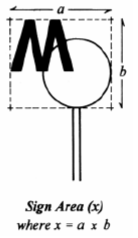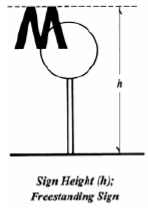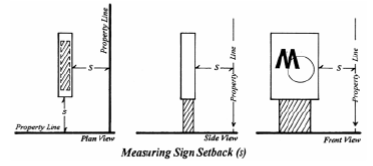(A) Sign area. The following principles shall control the computation of sign area and sign height within the village:
(1) Individual signs. The area of a sign shall be the smallest rectangle which encloses the extreme limits of the writing, representat ion, emblem, or other display, together with any material or color forming an integral part of the background of the display or used to differentia te the sign from the back drop or structure against which it is placed, but excluding the supporting framework, bracing, or decorative fence or wall when such fence or wall otherwise meeting zoning code regulations and is clearly incidental to the sign display itself.

(2) Multiple-faced signs. The sign area for a sign with more than one surface shall be computed by adding together the area of all sign surfaces visible from any one point. When two identical sign surfaces are placed back to back, so that both faces cannot be viewed from any point at the same time, and when such sign surfaces are part of the same sign structure and are not more than 12 inches apart, the sign area shall be computed by the measurement of one of the sign surfaces.
(3) Number of signs. For the purpose of determining number of signs, a sign shall be considered to be a single display surface or display containing elements organized, related, and composed to form a unit. Where matter is displayed in a random manner without organized relationship to elements, or where there is reasonable doubt as to the relationship of elements, each element shall be considered to be a single sign.
(B) Sign height. The height of sign shall be the distance measured between the top of the nearest public street curb and the highest point of the sign for freestanding signs. For all other signs, the distance measured between finished grade adjoining the wall on which a wall, projecting, awning, or window sign is attached and the highest point of said sign.

(C) Illumination . An illuminated sign is any sign from which artificial light emanates either by means of exposed lighting on the surface of the sign or through transparent or translucent material from a source within the sign, or a sign which reflects artificial light from a source intentionally directed upon it.
(1) Illuminated signs permitted in residential districts or located in any other zoning district adjacent a residential zoned lot shall not be illuminated between the hours of 11:00 p.m. and 7:00 a.m., unless the use to which the sign pertains is open;
(2) No illuminated sign shall be positioned or maintained so as to permit the beams and illumination there from to be directed or beamed upon any adjacent property nor to cause glare or reflection that may constitute a nuisance or traffic hazard;
(3) A photometric plan may be required by the village in order to confirm that light emitted by the sign does not exceed zero foot candles at the property line of the parcel or lot on which the sign is located.
(4) See § 159.129(L) for additional illuminance standards set forth for dynamic display/electronic message board signs.
(D) Set bac k. Exc ept as oth erw ise pro vid ed her ein , fre est and ing sig ns sha ll be located at least ten feet from any driveway and lot line. The setback of a sign shall be measured as the distance between the point of reference specified and the closest point on the sign.

(E) Electrical elements. All wiring, fittings, and materials used in the construction, connection and operation of electrically illuminated signs shall be in accordance with the provisions of the Romeoville Building Code and shall be contained in rigid conduit or enclosed in poles or raceways. No wiring may be exposed on the surface of any element of the sign.
(F) Sign maintenance. The owner of a sign or the premises on which such sign is located shall be liable for maintenance of such sign, including its source(s) of illumination, it’s neat and orderly condition (free of any debris), maintenance to ensure good working order at all times (i.e. functional light bulbs), and for preventing deterioration of the physical appearance (i.e. sign fading) or safety of such sign. Message board signs must be designed in such a manner that the message area is resistant to damage by wind and vandalism.
(G) Structural elements. The construction and structural components of all signs shall be in accordance with the standards and regulations of the Romeoville Building Code.
(H) Sight triangle. To protect the visibility of automotive traffic, bicyclists, and pedestrians, signs, and any concealed support elements supporting a sign, shall not be located within any sight triangle described in § 159.014.
(I) Overhang. Except awning, canopy and projecting signs, no sign may overhang any part of a structure, sidewalk, parking or loading space, driveway or maneuvering aisle.
(J) Window surface area. For the purposes of calculating window signage, window surface area shall be defined as all the glass surfaces, including windows and doors of a single tenant building or of a space in a multiple tenant building occupied by a single user, that make up the street-facing façade.
(1) All window signs shall occupy no more than 50% of the total window surface area of a storefront facing the public street.
(2) The Zoning Administrator or Village Manager may revoke the use of window signs at a particular location at any time if the window signage is deemed to limit visibility into a location in a matter that compromises public safety.
(Ord. 15-1190, passed 9-16-15; Am. Ord. 15-1229, passed 11-18-15; Am. Ord. 22-1794, passed 9-21-22)